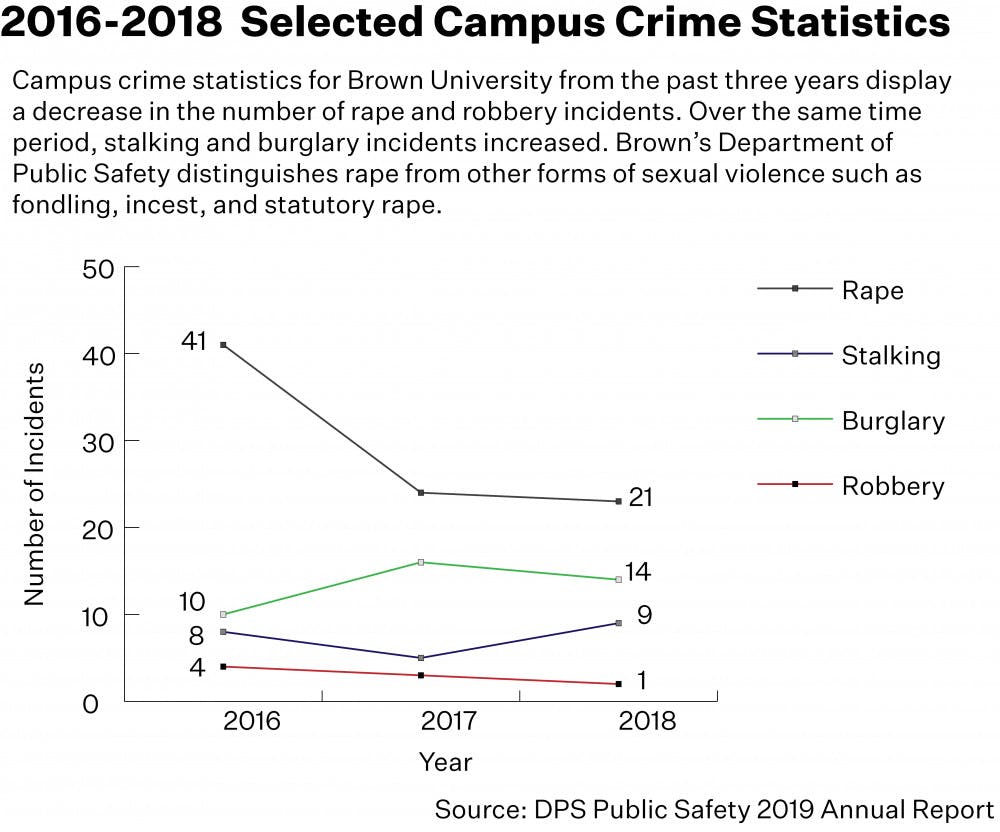The University Department of Public Safety reported an increase in off-campus burglaries, a decrease in on-campus robberies and a decline in reported rapes from 2016 to 2018 in its annual security report released early October.
DPS reported 21 incidents of rape in 2018, which followed 24 in 2017 and nearly double that amount — 41 — in 2016. While Title IX Officer Rene Davis did not give an explicit reason for the decreased number of reports in 2018 and the Sexual Harassment and Assault Resources and Education Advocates could not comment on the decrease, both contextualized last year’s decrease by describing the specific events that surrounded 2016’s spike.
The spike in reports in 2016 followed a 2015 recommendation by the University’s sexual assault task force for the creation of the Title IX office and mandatory sexual-assault prevention training for all members in the University community, among others, The Herald previously reported. The 2016 presidential election also brought conversations around sexual violence and sexual touching to the forefront, wrote Davis and SHARE Advocates Alana Sacks and Elliott Ruggles in emails to The Herald.
“These are all factors and triggers that could have supported an individual coming forward (in 2016),” Davis wrote.
“I still look at this crime as being an underreported crime,” said Department of Public Safety Chief of Police Mark Porter.
The decrease in reported rapes in the DPS annual report does not mirror reports of rape recorded in the 2019 Association of American Universities Campus Climate Survey on Sexual Assault and Misconduct. Though the number of rapes reported to DPS on campus fell from 2016 to 2018, the 2019 campus climate survey found that 11.6 percent of undergraduate women have experienced “non-consensual penetration” since enrolling at the University, a number significantly higher than any in the DPS annual reports. About sixty percent of women who experienced non-consensual sexual contact said that they did not report their experience to any University program or resource, per the survey.
The disparity in reported rapes in the DPS report compared to the AAU survey could stem from a number of factors. These range from underreporting to students that report their experiences to confidential resources such as Counseling and Psychological Services or the Chaplains office as opposed to the Title IX office or DPS, according to Davis.
The report also highlighted sharp increases in burglaries — the unlawful entry of a structure to commit a felony or theft — in Providence Police Department districts 9-2 and 9-3, which include the East Side of Providence from Power Street to Olney Street. These districts encompass almost all of College Hill.
Forty-two reported burglaries occurred in district 9-2, an increase from 27 in 2017 and 23 in 2016. Burglaries also spiked in district 9-3, rising to 60 in 2018 from 10 in 2017.
“I get the sense that property crime has been up,” Porter said, noting that a decrease in violent crime has accompanied it.
But the University saw a continued decrease in on-campus robberies — theft of property by force or the threat of force — in 2018, which continues a decade-long trend, Porter said. Forty-four robberies occurred from 2011 to 2014, while only 11 robberies occurred from 2015 to 2018, Porter wrote in an email to The Herald. Last year, only one robbery occurred on campus.
Porter attributed the sharp drop to the “high visibility” of DPS’ public safety staff — including contracted “yellow-jackets” who patrol the campus, DPS and Providence Police officers — in busy areas such as Thayer Street.
“We know that we’re not going to be crime free, so we try to reduce the crimes as much as we can,” he said.
Additionally, disciplinary referrals to DPS for drug abuse increased from 18 in 2017 to 34 in 2018. Porter attributed this to several conduct code violations that involved multiple students.
Fires on campus also increased in 2018, from three to four. Stephen Morin, Brown’s director of Environmental Health and Safety, wrote in an email that this year’s increase in fire incidents “cannot be attributed to any particular reason,” and the department doubts that they missed any fires.
The fire safety report showed four fire incidents to which the Department of Public Safety responded, including two off main campus on Bowen street, one in Grad Center and a “malicious” incident in Gregorian Quad A.
“We believe the incident to be intentional,” Morin continued, explaining that a piece of paper on the entrance door to the building was set on fire, leading the residence hall to be evacuated. The department’s investigation was unable to identify the person at fault.
Correction: A previous version of this article stated that 45 burglaries occurred in district 9-2 in 2018. In fact, 42 burglaries occurred in that district last year. The article has been updated to reflect that change. The Herald regrets the error.

Will Kubzansky was the 133rd editor-in-chief and president of the Brown Daily Herald. Previously, he served as a University News editor overseeing the admission & financial aid and staff & student labor beats. In his free time, he plays the guitar and soccer — both poorly.





